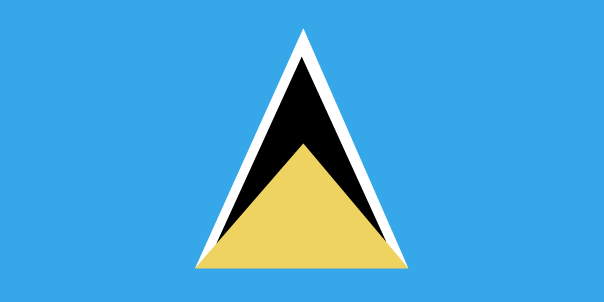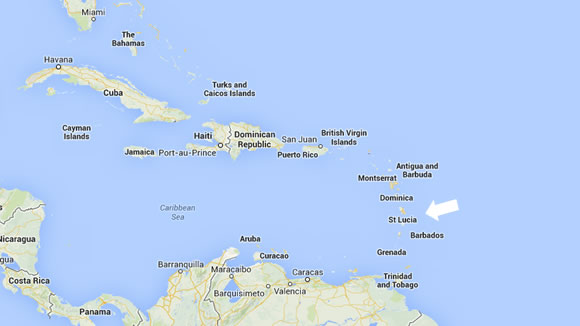About Saint Lucia – an Overview
St Lucia - Helen of the West
SYLLABICATION: Saint Lu·cia
PRONUNCIATION: Saint Loo Sha
LISTEN TO THE PRONUNCIATION (Wikipedia): St Lucia
Where in the world is Saint Lucia?
Saint Lucia, named after Saint Lucy of Syracuse (AD 283 – 304) is one of only two sovereign states in the world named after a woman. Legend states that French sailors were shipwrecked on the island on 13 December, the feast day of St. Lucy, and therefore named the island in her honour. [Wikipedia]
Ireland being the other, named after a goddess.
St Lucia is said to be one of the early finds of Christopher Columbus, describing it to be the most beautiful island in the region. Simply beautiful!
St Lucia is the emerald island in the Caribbean where you will find a unique mixture of history, culture, and quiet charm. It is rich in natural beauty, from inland tropical forests to dramatic waterfalls and lovely sandy beaches.
St Lucia is famous for the twin peaks of the magnificent Pitons, rainforest walks, waterfalls, golden beaches, and bubbling volcanic springs. It even boasts the world’s only drive-in volcano.
The St Lucian Jazz Festival attracts visitors from all over the world every May and Carnival in July is a week-long party for the whole island. St Lucians love to party and besides the annual flower festivals, Christmas, New Year, the Calypso Competition, and the Independence Day celebrations, some of the villages hold main street jump-ups every Friday night of the year.

Flag of Saint Lucia
History of Saint Lucia

Saint Lucia’s location in the region.
Promotional Video
Entertaining, yet educational Video
St Lucia at a glance
Full name: Saint Lucia
Location: Saint Lucia has an area of 238 square miles (616 square kilometers). It is 27 miles (43 K) long on its north-south axis and 14 miles (22 kilometers) at its widest east-west dimension. Saint Lucia lies between Saint Vincent to the south and Martinique (a French province) to the north.
Major languages: English (official), Saint Lucian Creole (French patois/Kwéyòl)
Saint Lucia’s official language is English. There is however another major local language, namely Saint Lucian French Creole (Kwéyòl). Locally referred to as Patois (“Patwa”), and is spoken by a majority of the local population.
Major religion [update]: Roman Catholic 50.6%, Protestant 25.8% (includes Seventh Day Adventist 10.6%, Pentecostal 9%, Baptist 2.2%, Anglican 1.6%, Church of God 1.5%, other Protestant 0.9%), other Christian 3.4% (includes Evangelical 2.3% and Jehovah’s Witness 1.1%), Rastafarian 1.9%, other 0.4%, none 5.9%, unspecified 1.4% (2010 est.)[CIA.gov][updated info – https://t.ly/GFHzC]
Life expectancy: 79.2 years (2023 est.); male: 76.5 years; female: 82.1 years [CIA.gov]
Ethnic Group: Black/African descent 85.3%, mixed 10.9%, East Indian 2.2%, other 1.6%, unspecified 0.1% (2010 est.)
Monetary unit: 1 East Caribbean dollar = 100 cents
EC – US: 1 US = 2.679 East Caribbean dollar
GNI per capita: US $5,530 (World Bank, 2008)
Internet domain: .lc
International dialling code: +1 758
Electricity: 220 ~ 240 volts, 50 cycles AC (a few hotels are 110 volts, 60 cycles). Most sockets take 3-pin square plugs (UK standard) but some take 2-pin round plugs or flat American plugs, which are rarer. Adaptors are generally available at the hotels.
Geography
Geographic coordinates: 13.901 N, -60.970 W
Area: total: Total: 616 sq km (238 sq miles) / land: 606 sq km/water: 10 sq km – 3.5 times the size of Washington, DC
Coastline: 158 km (61 sq miles)
Maritime Claims: Territorial sea: 12 nm / contiguous zone: 24 nm / exclusive economic zone: 200 nm / continental shelf: 200 nm or to the edge of the continental margin
Climate: Current Weather is tropical, moderated by northeast trade winds
– Dry season January to April
– Rainy season May to August
Terrain: Volcanic and mountainous with some broad, fertile valleys
Elevation extremes: Lowest point – Caribbean Sea 0 m / highest point – Mount Gimie 950 m
Natural resources: Forests, sandy beaches, minerals (pumice), mineral springs, geothermal potential
Natural hazards: Hurricanes; volcanic activity
Geography – note: The twin Pitons (Gros Piton and Petit Piton – see image below), striking cone-shaped peaks south of Soufriere, are one of the scenic natural highlights of the Caribbean.
St Lucia’s Government
Government type: Parliamentary democracy and a Commonwealth realm
Administrative divisions: 11 quarters:
– Anse-la-Raye; Castries; Choiseul; Dauphin; Dennery; Gros-Islet; Laborie; Micoud; Praslin; Soufriere, and Vieux-Fort
Independence: 22 February 1979 (from the United Kingdom – UK)
Legal system: based on English common law; has not accepted compulsory ICJ jurisdiction
Chief of state: King Charles III formerly Queen ELIZABETH II (since 6 February 1952); represented by Mr Cyril Errol Melchiades Charles as Acting Governor-General of Saint Lucia. His Excellency was sworn in at the Official Residence of the Governor-General on Thursday, November 11, 2021.
Note: The governor-general of Saint Lucia is the representative of the Saint Lucian monarch, currently King Charles III, in Saint Lucia. The governor-general is appointed by the monarch on the recommendation of the prime minister of Saint Lucia.
Acting Governor-General His Excellency replaces Sir Neville Cenac who demitted office on October 31st, 2021. Sir Neville Cenac was appointed as Governor-General on January 1st, 2018.
Head of government: Prime Minister Hon. Philip J. Pierre
Communication in St Lucia
The general assessment of Telephone Systems: adequate system
Domestic: the system is automatically switched
International: country code – 1-758; the East Caribbean Fiber Optic System (ECFS) and Southern Caribbean fiber optic system (SCF) submarine cables, along with Intelsat from Martinique, carry calls internationally; direct microwave radio relay link with Martinique and Saint Vincent and the Grenadines; tropospheric scatter to Barbados
Internet country code: .lc
Internet Speeds: up to 500Mbps
Main Telecommunication Companies: Flow, Digicel
Transportation in St Lucia
Civil aircraft registration country code prefix: J6 (2016)
Airports: 2: George F. L. Charles Airport (SLU) – North of the island, located in Castries Hewanorra International Airport (UVF) – South of the island, located in Vieux Fort
Airports – with paved runways: Total: 2 2,438 to 3,047 m: 1 1,524 to 2,437 m: 1 (2017)
Roadways: Total: 1,210 km Paved: 847 km Unpaved: 363 km (2011)
Ports and terminals: Major seaport(s): Castries, Cul-de-Sac, Vieux-Fort
Driving Side of the Road: Drivers drive on the Left-Hand side of the road, as in the UK
USA – be aware…
Modes of Getting Around St Lucia: Rental cars, Taxi, Mini Bus, Water Taxi, Ferries and Organized Tours
Ports and terminals: Major seaport(s): Castries, Cul-de-Sac, Vieux-Fort
Security in St Lucia
St Lucia is, for the most part, an idyllic and laid-back place, but it is not without its hazards and nuisances. As you would anywhere in the world, even in your own hometown, be alert and aware of your surroundings. As in any situation, be mindful about venturing alone in deserted or unlit areas as well as areas you are not familiar with.
The more densely populated areas like Castries and Rodney Bay are patrolled by police regularly and there are police stations in each of the island’s districts.
If touring the island, be sure to secure personal belongings on your person or leave them in a safe location in your room or villa. If you are staying in a hotel, which generally has gated security, take the precaution of informing your reception or concierge of your plans and anticipated return.
If hiring a car, don’t pick up strangers. If you are traveling by yacht, then inform neighboring yachts when you are going ashore for the day or evening. St Lucia’s many delights and its wonderful people are yours to safely enjoy while keeping these few precautions in mind.
Customs Regulations in St Lucia
Customs notes: The duty-free allowance into St. Lucia is 200 cigarettes or 250 grams of tobacco or 50 cigars, one liter of spirit or wine. Duty-free shopping is available at Pointe Seraphine, La Place Carenage, and at the departure lounge of Hewanorra Airport. Luxury items include Jewelry, Batiks, Giftware, Local Crafts, Liquor, Cigarettes, and Cigars.
Emergency numbers in St Lucia
Important numbers to remember:
Dial 999 to reach the police in an emergency, 911 for Fire, an ambulance, and other emergencies.
Important contact numbers to keep in mind Emergency Numbers
Note: the following number may or may not still be active and correct. All numbers sourced from various locations. If you do find any discrepancies, please let us know.
Police Headquarters: 758 456 3712
Marine: 758 452 2595
Crime Action Line: 758 458 2880
Fire/Ambulance
Castries: 758 452 2373
Soufriere: 758 459 7448
Vieux Fort: 758 454 6339
Electricity
North: 758 457 4443 / 758 457 4441
South: 758 457 4854 / 758 457 4855
WASCO
Castries: 758 457 3900
Disaster Preparedness (NEMO): 758 452 3802
Hospitals
Dennery: 758 453 3310
Gros Islet Polyclinic: 758 468 7630 / 758 468 7631 / 758 468 7637
Soufriere: 758 459 7258
St Jude’s (Vieux Fort): 758 454 6041
Tapion (Private): 758 459 2000
Victoria (Castries): 758 452 2421

